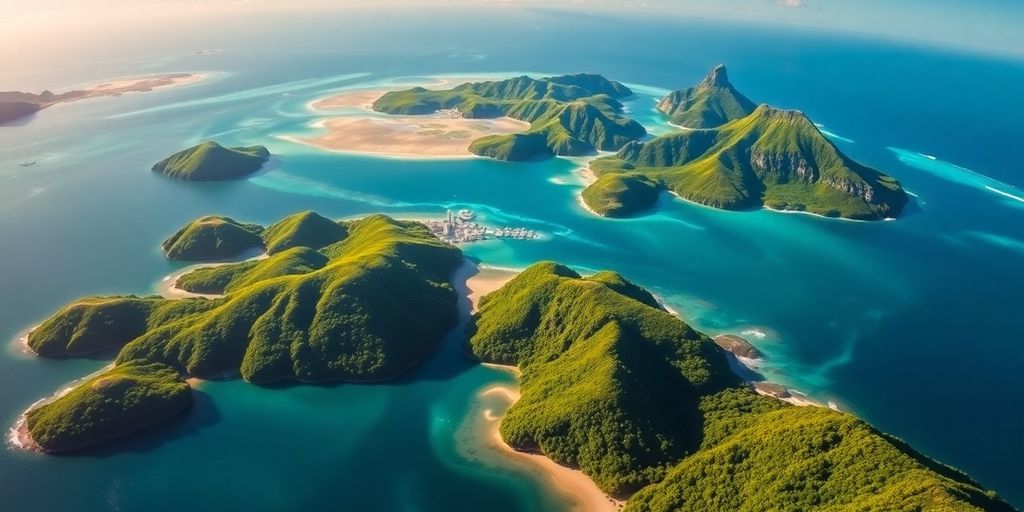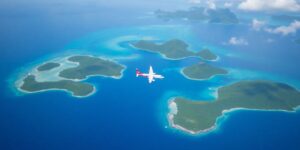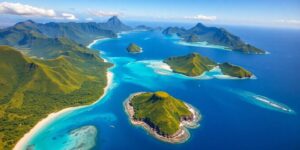So, you’re thinking about exploring French Polynesia with a camera in hand? Awesome choice. These islands are a dream for photographers. With the Air Tahiti Pass, you can hop from one breathtaking island to another. It’s like a buffet of stunning views and vibrant culture, waiting for you to capture. Whether it’s the blue lagoons, the green mountains, or the colorful traditions, there’s a photo op around every corner. Let’s dive into how you can make the most of your photography trip across these islands.
Key Takeaways
- The Air Tahiti Pass lets you explore multiple islands easily, perfect for photographers wanting diverse shots.
- Plan your itinerary to include a mix of popular spots and hidden gems for unique photo opportunities.
- Pack smart with lightweight gear, and protect your equipment from the island’s weather conditions.
- Time your visits to align with local festivals and the best weather for vibrant photos.
- Engage with local communities to capture authentic and respectful images of the culture.
Exploring the Beauty of French Polynesia for Photographers
Discovering Hidden Gems on Remote Islands
French Polynesia is a paradise for photographers, with its stunning landscapes and vibrant cultures. Remote islands like Huahine, Fakarava, and Rangiroa offer unique opportunities to capture untouched beauty. These islands are less crowded, providing a serene backdrop for your photography. You can find historical ruins on Aukena and the untouched beauty of Taravai. With the Air Tahiti Pass, island-hopping becomes effortless, allowing photographers to explore these hidden treasures seamlessly.
Capturing the Unique Culture and Traditions
The islands of French Polynesia are rich in culture and tradition. From traditional dance performances to local cuisine, there’s so much to capture. Photographers can immerse themselves in the vibrant cultural scenes of Moorea, Raiatea, and Taha’a. Participating in cultural events can provide photographers with authentic shots that tell the story of the island’s heritage. Embrace these experiences while respecting the local customs and traditions.
Photographing the Diverse Landscapes
The diverse landscapes of French Polynesia are a photographer’s dream. From the lush greenery of the islands to the clear blue waters of the lagoons, there’s no shortage of breathtaking scenes to capture. The Air Tahiti Pass makes it easy to explore different island groups, each offering unique landscapes and experiences. Whether it’s the rugged mountains of Bora Bora or the tranquil beaches of Moorea, every island has its charm. Photographers can experiment with different techniques to capture the essence of these stunning landscapes.
Maximizing Your Air Tahiti Pass for Photography Adventures

Planning Your Island-Hopping Itinerary
Getting the most out of your Air Tahiti Pass starts with a solid plan. You want to make sure you’re not just hopping from one island to another without a clue. Map out your journey by listing the islands you want to visit and what kind of photos you aim to capture. Maybe you’re after the serene beaches of Bora Bora or the rugged peaks of Nuku Hiva. Think about what each island offers and how it fits into your photography goals.
- List your must-see islands.
- Research the best photography spots on each island.
- Consider travel time between islands to avoid rushing.
Understanding the Benefits of the Air Tahiti Pass
The Air Tahiti Pass is like a golden ticket for island explorers. It offers a budget-friendly way to see multiple islands without the hassle of booking separate flights. You get to enjoy flexible travel dates, which is perfect if you’re waiting for the right weather conditions for that perfect shot. Plus, the pass supports eco-friendly travel by simplifying your itinerary.
- Cost-effective multi-island travel.
- Flexible scheduling options.
- Eco-friendly travel incentives.
Tips for Booking Flights and Accommodations
Booking flights and places to stay can be a bit of a puzzle, but with a few tricks, it becomes manageable.
- Book flights early to secure your desired itinerary.
- Look for accommodations close to key photography spots.
- Consider staying in locally-owned lodgings to immerse yourself in the culture.
Traveling with the Air Tahiti Pass is not just about moving from one place to another. It’s about experiencing the unique charm of each island and capturing those moments through your lens. Make sure you plan well to make the most out of your adventure.
For more on how the Air Tahiti Pass transforms island hopping into an accessible adventure, check out our detailed guide.
Essential Photography Gear for Island Expeditions
Choosing the Right Camera and Lenses
Heading out to the islands with the wrong gear is like bringing a spoon to a knife fight. You want to make sure you’ve got the right camera and lenses to capture those jaw-dropping landscapes and vibrant cultures. A good DSLR or mirrorless camera is a must-have for any island photographer. Pair it with a versatile lens, like a 24-70mm, and you’re golden. For those stunning close-ups, a macro lens can be a game-changer. Don’t forget a wide-angle lens to capture the sweeping vistas that make these islands so special.
Packing Lightweight and Efficient Equipment
When you’re bouncing between islands, you don’t want to be lugging around a ton of gear. Keep it light and efficient. A sturdy, yet lightweight tripod is essential for those long-exposure shots. Consider a camera bag that’s both waterproof and comfortable to carry. Here’s a simple packing list to keep you organized:
- Camera body with two lenses
- Lightweight tripod
- Waterproof camera bag
- Extra batteries and memory cards
Protecting Your Gear from the Elements
Island weather can be unpredictable, with sudden rain showers or intense sun. Protecting your gear is crucial. Use rain covers for your camera and lenses, and always have a microfiber cloth handy to wipe off any moisture. A UV filter not only protects your lens but also helps reduce glare from the water and sand.
Remember, the beauty of these islands is in their natural state. Keeping your gear safe ensures you can capture that beauty without any hiccups.
For those planning to explore the hidden islands of Tahiti with the Air Tahiti Pass, having the right gear ensures you won’t miss any of the breathtaking landscapes or vibrant cultures that await. Whether you’re island-hopping or diving into the local culture, your equipment should be as ready for adventure as you are.
Best Times of Year to Photograph in French Polynesia
Understanding the Seasonal Weather Patterns
French Polynesia is a paradise for photographers, but timing your visit can make all the difference. The islands enjoy a tropical climate, with two main seasons: the wet season from November to April and the dry season from May to October. The dry season is generally the best time for photography. You’ll find less rain and more sunny days, which means clearer skies and vibrant colors. During this time, the humidity is lower, making it more comfortable to explore and shoot.
| Season | Months | Weather Characteristics |
|---|---|---|
| Wet Season | November-April | High humidity, frequent rain showers |
| Dry Season | May-October | Less rain, cooler temperatures |
Capturing the Vibrant Colors of the Islands
In French Polynesia, colors pop all year round, but the dry season enhances them even more. The turquoise waters, lush greenery, and stunning sunsets are more vivid. This is the time when everything seems to come alive. The ocean sparkles under the bright sun, and the landscapes are just begging to be photographed. For those who love capturing nature in its most vibrant form, plan your trip during these months.
Timing Your Visits for Cultural Festivals
Cultural festivals offer a unique opportunity to capture the essence of French Polynesia. These events are rich in tradition and provide a colorful backdrop for any photographer. The Heiva Festival, a major cultural event, usually takes place in July. It’s a time when locals celebrate their heritage through dance, music, and traditional costumes. If you time your visit right, you can capture these lively scenes and add a cultural depth to your portfolio.
French Polynesia offers a stunning palette of opportunities for photographers. Whether you’re there for the landscapes or the cultural vibrancy, planning your trip around the seasons can enhance your experience and your photos.
Top Islands to Visit with the Air Tahiti Pass
Exploring the Iconic Bora Bora
Bora Bora is often the first island that comes to mind when thinking about French Polynesia. Known for its stunning lagoons and overwater bungalows, it’s a paradise for photographers. Capture the mesmerizing sunsets and the vibrant marine life. Don’t forget to visit the local markets to snap some photos of the colorful displays and friendly vendors.
Discovering the Untouched Beauty of Taha’a
Taha’a is known as the "Vanilla Island" because of its abundance of vanilla plantations. The island offers a more authentic experience compared to its more touristy neighbors. Photograph the lush green landscapes and the serene beaches. A trip to Taha’a is incomplete without a visit to a vanilla farm, where you can capture the process of vanilla production.
Photographing the Rugged Landscapes of Nuku Hiva
For those who love adventure, Nuku Hiva is the perfect destination. The island’s rugged terrain and dramatic cliffs offer endless opportunities for breathtaking photography. Hike through the dense forests and capture the majestic waterfalls and ancient archaeological sites. Nuku Hiva’s landscapes are as diverse as they are stunning, providing a unique backdrop for any photographer.
With the Air Tahiti Pass, you can easily hop from one island to another, exploring each unique landscape and culture without the hassle of booking separate flights. It’s the perfect way to experience the diverse beauty of French Polynesia.
Techniques for Capturing Stunning Island Photography

Mastering Aerial Photography with Drones
Flying a drone over the islands is like having a bird’s-eye view of paradise. Mastering drone photography can really change how you capture these beautiful places. First, check the local rules about flying drones. You don’t want to get in trouble with the locals or authorities. Then, practice flying in open spaces before heading to those tight spots. Try shooting during the golden hour, which is just after sunrise or before sunset, to get those dreamy, soft light shots.
Utilizing Natural Light for Dramatic Effects
When you’re out on the islands, natural light is your best friend. It’s all about timing and knowing when the light is just right. Early mornings and late afternoons are perfect for capturing those long shadows and warm hues. If you’re shooting in the middle of the day, try finding some shade or using a polarizing filter to cut down on glare. And don’t forget to play with shadows and highlights to create some drama in your shots.
Composing the Perfect Shot in Paradise
Composition is key to making your photos stand out. Start by using the rule of thirds to balance your shots. Imagine your frame divided into nine equal parts and try to place your subject along these lines or at their intersections. This simple trick can make your photos more engaging. Also, look for leading lines, like pathways or waves, to draw the viewer’s eye into the scene. And don’t be afraid to experiment with angles—sometimes the best shot comes from lying on the ground or climbing up high.
"Photography is about capturing a moment that won’t ever happen again. It’s about seeing something special and making it last forever."
For more photography tour opportunities in the South Pacific, check out what’s available in places like Vanuatu and Fiji. They offer a chance to engage with local communities and capture stunning landscapes.
And if you’re into whale watching, make sure to bring a wide-angle lens for those expansive ocean views. You won’t regret it!
Connecting with Local Communities for Authentic Shots
Building Relationships with Island Residents
When you’re hopping from island to island with the Air Tahiti Pass, building genuine connections with the locals can transform your photography. It’s not just about snapping pictures; it’s about capturing the soul of the place. Start by spending time in community spaces like markets or local gatherings. Smile, be polite, and show genuine interest in their stories. You might be surprised how a simple conversation can lead to a photo opportunity that captures the true essence of local life.
Participating in Traditional Ceremonies
One of the most enriching experiences you can have is joining in on traditional ceremonies. These events offer a glimpse into the heart of the culture. Whether it’s a dance, a festival, or a more solemn event, always ask for permission before taking photos. Respect and courtesy go a long way. Bring a small gift or offer to share your photos with them as a token of appreciation.
Respecting Cultural Sensitivities in Photography
Every island has its own cultural nuances, and it’s crucial to be aware of them. Some places might have restrictions on photographing certain ceremonies or sacred sites. Always ask if you’re unsure. When in doubt, err on the side of caution and prioritize respect over the perfect shot. This approach not only preserves the dignity of your subjects but also builds trust within the community.
Spending time in local communities not only enriches your travel experience but also gives your photographs depth and meaning. It’s about more than just images; it’s about telling a story that resonates with authenticity.
Editing and Enhancing Your Island Photographs

Using Software to Highlight Natural Beauty
When you’ve captured the magic of French Polynesia, the next step is to make those photos pop. Editing software can transform your images, bringing out the vibrant colors and stunning details that make these islands so special. Whether you’re using Adobe Lightroom, Photoshop, or a free alternative like GIMP, each tool offers unique features that can help you enhance your photos.
Here’s a quick rundown of what you might focus on:
- Adjusting brightness and contrast to make your images more dynamic.
- Tweaking saturation and vibrance to bring out those lush greens and turquoise blues.
- Sharpening details to make sure every leaf and wave is crisp.
Techniques for Color Correction and Enhancement
Color correction is key when it comes to making your photos look natural yet striking. You might find that your camera didn’t quite capture the scene as you remembered it. That’s where color correction comes in.
- White balance: Adjust this to make sure the whites in your photo are truly white, which will balance out the rest of the colors.
- Hue and saturation: Play around with these settings to emphasize the colors you want to stand out.
- Exposure: Sometimes you need to lighten or darken your image to get the right mood.
Creating a Cohesive Visual Story
Your photos tell a story, and editing can help you weave that story together. Consistency is important. When editing a series of photos, try to maintain a similar style across them all. This could mean using the same filter or preset, or simply keeping your edits subtle and uniform.
"Editing isn’t just about making your photos look good—it’s about bringing your memories to life. Each adjustment can help convey the feeling you had when you were there, standing on that beach, watching the sun dip below the horizon."
By focusing on these editing techniques, you’ll make your island photos not just snapshots, but works of art that capture the essence of your adventure. And remember, learn how to edit and enhance your whale photos to further improve your skills and preserve those unforgettable moments.
Sharing Your French Polynesia Photography with the World
Building an Online Portfolio or Blog
Creating an online portfolio or blog is a great way to showcase your photos from French Polynesia. A well-organized portfolio can make your work stand out. Use platforms like WordPress or Squarespace to build your site. Keep it simple and let your images do the talking. Write short descriptions for each photo to give context. This not only helps viewers understand your work but also adds a personal touch.
Utilizing Social Media Platforms for Exposure
Social media is a powerful tool to share your photography. Platforms like Instagram and Facebook are perfect for reaching a wider audience. Post regularly, and use relevant hashtags to increase visibility. Engage with your followers by responding to comments and messages. This interaction can create a loyal community around your work. Remember, consistency is key to building your presence online.
Entering Photography Contests and Exhibitions
Participating in photography contests and exhibitions can give your work more exposure. Look for contests that align with your style and subject matter. Winning or placing in these contests can boost your credibility as a photographer. Exhibitions, whether online or in galleries, provide a platform to showcase your work to new audiences. Keep an eye out for local and international opportunities to display your photos.
Sharing your photography isn’t just about getting likes or followers. It’s about connecting with people who appreciate your art and the stories behind each image. Whether it’s through a blog, social media, or an exhibition, your photos have the power to inspire and evoke emotions.
Sustainable Photography Practices in French Polynesia

Minimizing Environmental Impact While Shooting
When capturing the breathtaking beauty of French Polynesia, it’s crucial to be mindful of the environment. Always stick to designated paths to avoid damaging delicate ecosystems. Carry out all trash and avoid disturbing wildlife. Consider using digital photography over film to reduce chemical waste.
Supporting Local Conservation Efforts
Engaging with local conservation projects can enhance your experience and contribute positively to the environment. Participate in beach clean-ups or volunteer for reforestation projects. By supporting local conservation efforts, you help maintain the natural beauty that makes this region so unique.
Educating Others About Responsible Photography
Share your knowledge and experiences with others to promote responsible photography. Use your platform to highlight the importance of eco-friendly practices. Encourage fellow photographers to adopt sustainable habits, like using sustainable materials and reducing their carbon footprint when traveling between islands with the Air Tahiti Pass.
Practicing sustainable photography not only protects the environment but also ensures that future generations can enjoy the same stunning landscapes and vibrant cultures. By being a responsible photographer, you contribute to the preservation of French Polynesia’s natural and cultural heritage.
In French Polynesia, we can all do our part to protect the beautiful environment while enjoying photography. By using eco-friendly practices, like minimizing waste and respecting wildlife, we can capture stunning images without harming nature. Join us in making a difference! Visit our website to learn more about sustainable photography and how you can help.
Wrapping It Up
Traveling across the islands with the Air Tahiti Pass is like opening a treasure chest of photo opportunities. Each island has its own vibe and beauty, making every click of the camera a new adventure. Whether you’re snapping a sunset or capturing the local life, there’s always something that catches the eye. The pass makes it easy to hop from one island to another, so you can focus on getting that perfect shot without worrying about logistics. So pack your camera, grab the pass, and get ready to fill your photo album with memories from paradise. It’s a trip you won’t forget, and the photos will be your best souvenirs.
Frequently Asked Questions
What is the Air Tahiti Pass?
The Air Tahiti Pass is a special ticket that lets you fly to different islands in French Polynesia. It’s great for people who want to explore many places without buying separate tickets for each island.
How can I plan my island-hopping trip?
Start by picking the islands you want to visit. Then, check the flight schedules and book your Air Tahiti Pass. Make sure to also book your hotels and plan what you want to see and do on each island.
What kind of camera should I bring?
Bring a camera that you are comfortable using. A DSLR or a mirrorless camera with a few lenses is a good choice for capturing different scenes. Don’t forget extra batteries and memory cards!
When is the best time to take photos in French Polynesia?
The best time is during the dry season, from May to October, when the weather is sunny and the skies are clear. This is perfect for bright and colorful photos.
How can I take good photos with my drone?
Make sure to follow the local rules for flying drones. Practice using your drone before your trip, and try to shoot during sunrise or sunset for the best light.
How do I keep my camera safe from the weather?
Use a waterproof bag or cover to protect your camera. Avoid changing lenses in wet or sandy places, and always wipe your camera dry if it gets wet.
Why is it important to respect local cultures when taking photos?
Respecting local cultures shows that you care about the people and their traditions. Always ask for permission before taking someone’s photo and be polite.
How can I share my photos with others?
You can share your photos by creating an online blog or portfolio. Social media is also a great way to show your work to friends and family. You might even enter photography contests to get more exposure.




